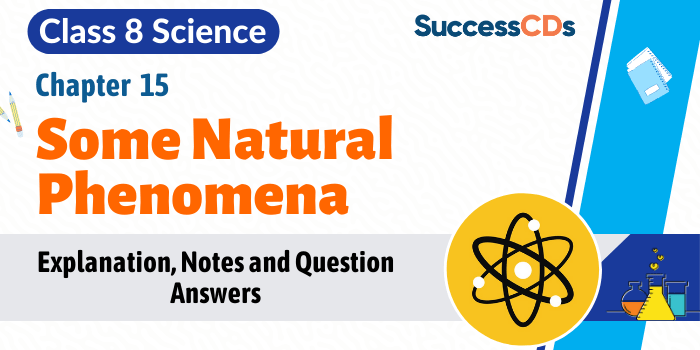
Some Natural Phenomena Class 8 Science Chapter 15 as per NCERT Book used in CBSE and other Schools. The lesson covers the complete explanation of class 8 Chapter 15 Some Natural Phenomena. Topics covered are Electric charges and Electroscope, Lightening and Earthquake. The lesson covers all important questions and NCERT solutions to book questions have also been provided for convenience of the students.
- electric charge
- lightning
- earthquake
- types of charge and their interaction
- lightning conductor
- Richter scale
- transfer of charge
- lightning safety
- NCERT Book solutions
Electric charge
We all have noticed the phenomenon that when we rub the plastic scale on dry hair, the scale can attract small pieces of paper. It is because it becomes charged, that is, it acquires small charge.
Some Natural Phenomena Class 8 Video Explanation
When two objects are rubbed with each other, electrons may get transferred from one object to another. If an object loses some electrons, this object becomes positively charged. If an object gains electrons, this object becomes negatively charged. The transfer of charges is responsible for static electricity in various objects. Static electricity is the main reason of lightning. For example, when a plastic comb is rubbed with dry hair, it acquires a small charge. The second example is that when a plastic refill is rubbed with polythene, it acquires a small electric charge. The third example of this is that when we rub a plastic scale on your dry hair, the scale can attract very small pieces of paper.
This process proves that by rubbing bodies, the bodies get charged. These bodies are called charged bodies. That is why while we remove woollen clothes we feel sparking sensation. This is due to charge present in them.
Types of charge and their interaction
- Positively charged bodies
- Negatively charged bodies
Let us perform an activity before starting with types of charges:
To perform this activity, we need to firstly take two inflated balloons and then these balloons should be hung in such a way that they do not touch each other. Then we need to rub both the balloons with woollen cloth and release them. At last we will notice that they start moving away from each other. This shows that they acquire same charge and hence, it proves the reason that they move away from each other.

Now let us perform another activity:
For this activity we need to take a refill of pen and rub it with polythene. Then place it in a tumbler (using it as a stand). Then we need to rub another refill with polythene and bring it close to the previous refill. At last we will notice that they both repel each other.
 Now we’ll do another activity:
Now we’ll do another activity:
In this activity we bring charged bodies of different materials. Let’s say we try to bring inflated balloon rubbed with woollen cloth closer to the refill which was made charged by rubbing it with polythene. We will notice that they both try to move closer to each other or they both will attract each other.
These three activities conclude that:
- A charged balloon repelled another charged balloon.
- A charged refill repelled another charged refill.
- A charged balloon attracts a charged refill which clearly indicated that the charge on balloon was different from the charge on the refill. That is why they attract each other.
From these activities we conclude that charges are of two types:
- Positive charge
- Negative charge
This idea came from the fact that when we rubbed glass rod with silk, the glass rod acquired positive charge and silk cloth acquired a negative charge. The electric charges produced by rubbing both of them are static (stationary) but when charges move, they constitute the current.
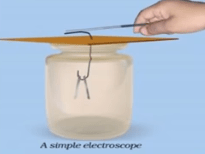 Transfer of charge
Transfer of charge
To explain this let us perform an activity.
- Firstly we need to take an empty jam bottle and a cardboard slightly bigger in size. Then we need to place it on a mouth of bottle pierce (a hole in it) so that metal paper clip can be inserted.
- Then cut two strips of aluminium and hang them on a paper clip.
- Then we need to charge a refill and touch it with the end of paper clip.
- Observe what happens.
- At last, we will notice the effect on foil strips.
- We will see the strips move away from each other or they repel each other.
Conclusion
From the above activity we can conclude that when charged refill is brought near the paper clip, the charge from clip transfers to metal foil. As both the strips acquire the same charge as that of refill therefore they repel each other and move away from each other.
But when we touch the charged paper clip with hand we will notice the foils again collapse. The reason being is that when you touch it with hand they transfer their charge to earth through our body and as a result they become discharged. This process of transferring change from charged body to earth is called earthing. Earthing is provided in buildings to protect us from electrical shocks due to any leakage of electrical current. The device that is used to detect the charge on the bodies is called an electroscope.
There are so many destructive phenomena to some extent. Like volcano’s, lightning, earthquakes etc.
Now we are going to discuss about two important phenomena:
- Lightning
- Earthquake
Lightning
- It is an electric spark on huge scale. For example, During rain, the air currents move upwards and water droplets in the form of rain, move downwards.
- It is caused due to accumulation of charges on clouds.
- On a stormy day, large particles of clouds gather electric charge. As we know, in clouds there are many small and large water droplets.
- From this, the smaller water droplets acquire positive charge and move towards the upward region in clouds. On the other hand, the larger water molecules acquire negative charge and move downwards.
- Now when two clouds carrying charge come closer to each other, a discharge occurs through a small air gap between the clouds. The discharge accompanies huge amounts of heat, sound and light.
- The clouds at the lower end charge the buildings and tress by the process of induction in such a way that they acquire opposite charge with respect to clouds. Due to this heavy flow of charge occurs between buildings and clouds. This heavy flow can damage several buildings.
- This flow of charge from clouds to earth is called lightning.
- This lightning is harmful as well as has certain advantage too.
Disadvantage of lightning-
It can destroy properties and life. It means it can be fatal.
Advantage of lightning-
- The advantage of lighting is that it causes the combination of atmospheric nitrogen with hydrogen to form ammonia that is an important constituent of nitrogenous compound.
- It also allows combination of oxygen and ozone that protects solar radiations and does not allow the ultraviolet radiations to come to the earth.
O2 + O → O3 (ozone)
Lightning conductor

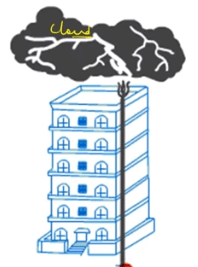
- Lightning conductor is a device developed by Benjamin Franklin to protect property from the damage caused by lightning. These conductors are installed in tall buildings, tower etc.
- It consists of thick flat metallic strip which is mostly made of copper.
- In lightning conductor, the top of the strip is in the form of spike which project out from building and the bottom is immersed deep in earth joined to metallic plate.
- There is also a metal strip which runs throughout the length of building.
- When lightning strikes the lightning conductor projecting out provide the oath for the flow of charge throughout the strip down into earth to the metal plate.
- The earth having zero potential does not experience any damage.
Lightning safety
We need to take the following precautions –
If we are outside our house:
 Once we hear the thunder sounds, we should rush to a safe place.
Once we hear the thunder sounds, we should rush to a safe place.- We should not stand under tall trees, shelters in park or near any elevated place, etc.
- We should not drive when we hear thunder storm or if we are driving, we need to stop the vehicle immediately. As we know that vehicle’s body is metallic in nature and metals are good conductors of electricity. That is reason we should not drive while thunder storming.
- We should not carry an umbrella as it is not safe during thunderstorm. Also umbrella has metals wires which could be harmful during thunder storm.
- We should stay away from poles and metal objects.

 We should not lie on ground.
We should not lie on ground. - Instead, squat low on ground place your hands on knees with your hand on knees and head between hands so that you are the smallest target to be struck.
The following precautions need to follow while we are inside the house:
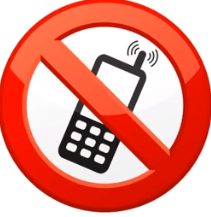 During lightning a contact with telephone wires, electrical wires should be avoided.
During lightning a contact with telephone wires, electrical wires should be avoided.- We should not use mobile phone as it is not safe to use mobile phones.
- Bathing should be avoided or avoid contact with running water.
- Electrical appliances should be unplugged.
Time to check your knowledge by answering these questions-
Question: Explain why a charged body loses its charge when we touch it with our hands.
Answer: When we touch a charged body with our hands, the excess accumulated charge or static charges on it get transferred to the earth through our body. Thus, the charged body loses its charge and becomes neutral.
Question: Suggest three measures to protect you from lightning.
Answer: If we are inside a home, we should avoid using the telephone except for emergencies.
If outside, within no time, reach to a safe building or an automobile.
Do not stand underneath a natural lightning rod such as a tall, isolated tree.
Question: What do you mean by lightning conductor? Explain.
Answer: Damages due to lightning flashes are very common. But with the help of a lightning conductor, we can save our large buildings on which we have spent lots of money. The lightning conductor consists of a large number of sharp pointed heads. They are usually attached on the top of buildings. Their pointing heads are made of a conducting material such as a copper wire. Then this copper wire of large length runs down along either side of the building (down). At the bottom, it is attached to a metallic plate which is inserted into the ground. When lightning strikes, the lightning conductor provides an easy path for the charge to pass through to the earth, thus protecting the building. Hence, our building will be saved by using this lightning conductor.
Question: Why does lightning usually strike tall buildings?
Answer: Lightning tends to strike the taller objects in an area, such as tall buildings and trees. It’s not that those objects attract lightning, it’s just that lightning is the result of two narrow channels of opposite charge making contact with each other, and the charge flows easier through these objects as opposed to air, so the taller the object, the lesser air the charge has to build through.
Question: How does lightning conductor work? Explain with the help of a diagram?
Answer: Lightning Conductor is a device used to protect buildings from the effect of lightning. A metallic rod, taller than the building, is installed in the walls of the building during its construction. One end of the rod is kept out in the air and the other is buried deep in the ground. The metallic rod provides an easy route for the transfer of electric charge to the ground.
Let us discuss how it Works
The lightning conductor consists of a large number of sharp pointed heads. They are usually attached on the top of buildings. Their pointing heads are made of a conducting material such as a copper wire. Then this copper wire of large length runs down along either sides of the building (down). At the bottom, it is attached to a metallic plate which is inserted into the ground. When lightning strikes, the lightning conductor provides an easy path for the charge to pass through to the earth, thus protecting the building. Hence, our building will be saved by using this lightning conductor.
Question: What were the things used in Benjamin Franklin’s kite experiment?
Answer: He attached his kite to a silk string, tying an iron key at the other end. Next, they tied a thin metal wire from the key and inserted the wire into a Leyden jar, a container for storing an electric charge. When the thunderstorm approached, they attached a silk ribbon to the key. Holding onto the kite by the silk ribbon, Benjamin flew the kite and once it was aloft, he went into a barn so that he would not get wet.
Question: Name some destructive natural phenomena.
Answer: Earthquake, tsunami are the two destructive natural phenomena.
Question: Name two events (other than an earthquake) which can cause tremors on the earth.
Answer: Erruption of volcanoes and tsunami are the two natural tremors on the earth.
Question: What is the main purpose of providing earthing in buildings?
Answer: There are two main purposes for grounding the electrical AC system: one is the immediate discharge of electrical energy to the earth in the event of electrical potential developed at that part of the system and the other is to maintain within acceptable limits, excess voltages on the system due to lightning, line surges, and incidental contact with higher voltages.
Question: Let us suppose you are in a forest, suddenly a thunderstorm came. Should you stand under the tree? Why/why not?
Answer: No, one should not stand under the tree because lightning goes into the earth through some medium.
 Earthquake
Earthquake
There are so many phenomena that can cause large destruction but the weather department can predict its occurrence and can warn before like we discussed lightning, but there are certain natural phenomena like earthquakes which cannot be detected prior and we do not know about their occurrence.
Earthquake is defined as sudden shaking or trembling of earth which lasts for short period of time. It is caused by a disturbance deep inside the earth’s crust. Earthquake can cause lot of damage to buildings, people etc.
Causes of Earthquakes
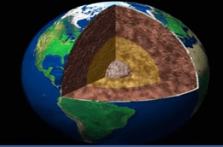 If we talk about its cause there are so many myths related to it but the cause which is most accepted is written below:
If we talk about its cause there are so many myths related to it but the cause which is most accepted is written below:
There are three layers of earth and that are crust, mantle, and core. The outermost layer of earth is not in one piece and it is fragmented and each fragment is called a plate or earth plates. These plates are in continual motion (means these plates are not static). When these plates collide with one another, then a plate goes under another plate due to collision and this thereby causes disturbance in the earth crust. Due to this disturbance earthquake occurs that is tremors take place.
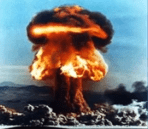 There are certain other causes of eathquakes that are as follows:
There are certain other causes of eathquakes that are as follows:
- Volcano eruptions
- Hitting of meteors on earth.
- Underground nuclear explosions.
As you know that earthquakes occur due to collision of plates. Therefore, the boundaries of plates are weak zones where the earthquake is likely to occur. The week zones are called “Seismic zones” or fault zones and these areas are more prone to earthquake.
The places of Seismic zones in India are as follows:
- Kashmir
- Western and central Himalayas
- The whole north east
- Great Rann of Kutch in district of Gujarat
- Some areas of south India
Now we are to discuss about the scale that can actually make us familiar with the strength of earthquake.
Richter scale
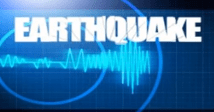 Richter scale is a scale that helps in measuring the strength of earthquake. The tremors produce waves on the surface of earth. These waves are called seismic waves. These waves are recorded by an instrument called the seismograph. This instrument is simply a vibrating rod or a pendulum which starts vibrating when tremors occur.
Richter scale is a scale that helps in measuring the strength of earthquake. The tremors produce waves on the surface of earth. These waves are called seismic waves. These waves are recorded by an instrument called the seismograph. This instrument is simply a vibrating rod or a pendulum which starts vibrating when tremors occur.
Seismograph has a pen which is attached to the vibratory system. The pen records the waves on paper which moves under it. By studying these waves, scientists can construct a complete map of earthquake. They can also estimate the power to cause destruction.
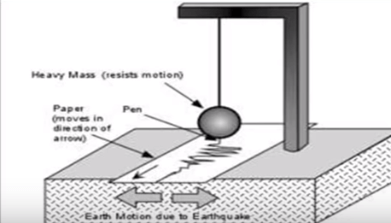
Protection against Earthquakes
Here are the instructions that we need to follow in seismic zones.
All the buildings in this zone is designed in such a way that they can withstand tremors.
For Example:
- We should consult qualified architects and engineers. They will be helpful for us as they are more aware of the building’s structure and they can make a building which is very strong.
- In these zones we should use mud and timber as it is better than using heavy construction materials.
- We should fix cupboard as it is better to fix cupboard and shelves into walls.
- We should be very careful while hanging clocks, photo-frames etc.
- All buildings should have fire fighting equipment as due to tremor the fire may take place.
Precautions
The precautions which are necessary to take if we are at home.
- We should take shelter under a table and stay there till the shaking stops.
- We should stay away from tall trees and heavy objects.
- We should not wake up if we were sleeping on bed while earthquake and we should not get up.
- We should protect our head with pillow.
The precautions which are necessary to take if we are outside home are as follows –
- We should firstly need to find a clear spot away from building, trees and overhead power lines. Drop to the ground.
- If you are in car or a bus while earthquake, you should not come out. At that time, you need to ask the driver to drive slowly to clear spot.
- We should not come out till the tremors stop.
NCERT Book Solutions
1. What happens when like charges come close to each other?
(a) repel
(b) move away
(c) attract
(d) none of these
Answer: repel
2. How do trees get burned?
(a) floods
(b) lightning
(c) earthquake
(d) thunder
Answer: lightning
3. Movement of the tectonic plates leads to which of the following option?
(a) floods
(b) earthquake
(c) lightning
(d) tsunami
Answer: earthquake
4. Which of these is not a seismic zone in India?
(a) Rajasthan
(b) Eastern part
(c) Kashmir
(d) Rann of Kutch
Answer: Eastern part
5. What happens when an uncharged body B is brought into contact with a positively charged body A?
(a) A loses its charge
(b) B acquires positive charge
(c) B acquire no charge
(d) B acquires negative charge
Answer: B acquires negative charge
6. What is an earthquake of magnitude 8-9 is?
(a) strong
(b) very strong
(c) mild
(d) not felt
Answer: very strong
7. The first established conductor was made by a scientist named ____ ?
(a) Issac Newton
(b) Benjamin Franklin
(c) Robert Hooke
(d) Thales
Answer: Benjamin Franklin
8. The magnitude of an earthquake is measured on the:
(a) Celsius scale
(b) Decibel scale
(c) Kelvin scale
(d) Richter scale
Answer: Richter scale
9. The SI unit of electric charge is:
(a) watt
(b) joule
(c) coulomb
(d) ampere
Answer: coulomb
10. An earthquake under the ocean can cause a:
(a) tsunami
(b) lightning
(c) thunderstorm
(d) hide tide
Answer: tsunami
Fill in the blanks with suitable words-
- A break or a crack between moving plates is called _____
- A _________ protects tall buildings from lightning.
- The loud sound produced during lightning is called ______
- In an atom, _______ are negatively charged particles.
- Combing your hair makes a ______ charge on the comb.
- An electroscope is used to ________ charge.
- Bathing should be avoided during a thunderstorm to avoid contact with _______
- Most of the earthquakes are caused by the movement of earth’s _______
Answers:
- slide
- lightning conductor
- thundering
- electrons
- negative
- detect
- conductor
- tectonic plates
State whether the following statements are True or False-
- A gold leaf electroscope is used to produce charges.
- The air in the path of the lightning becomes very cold.
- Like charges attract each other.
- Lightning conductor cannot protect a building from lightning.
- We should avoid taking a shower when it is lightning.
Answers:
- False
- False
- False
- False
- True
Question: Explain why a charged body loses its charge if we touch it with our hand.
Answer: When we touch a charged body, it loses its charge, due to the process of earthing. Our body is a good conductor of electricity and so it transfers the charges to the earth.
Question: Explain why a charged balloon is repelled by another charged balloon whereas an uncharged balloon is attracted to another charged balloon.
Answer: A charged balloon is repelled by another charged balloon because both the balloons contain same type of charges. We know that like charges repel each other.
But when one balloon is charged while other is uncharged, they do not have same charges. Therefore, charged balloon attracts uncharged balloon. Also, we know that opposite charges attract each other.
Question: Name the scale on which on which the destructive energy of an earthquake is measured. Would it be recorded by a seismograph? Is it likely to cause much damage?
Answer: The scale used to measure earthquake is Richter scale. Yes, it would be recorded by seismograph. The earthquake with magnitude of 3 on Richter scale is not likely to cause much damage.
Question: Let us suppose you are outside your home and an earthquake strikes. What precautions woud be you need to take to protect yourself?
Answer: The following precautions should be taken:
- We should move to an open space.
- We should not take shelter under trees or buildings.
- If we are driving, we should slow down the vehicle and move away from that area to a clear spot.
Question: Suppose you are outside your home and an earthquake strikes. What precautions would you take to protect yourself?
Answer: If we are outside the home, we need to reach to a safe building or an automobile within no time.
- We should not stand underneath a natural lightning rod such as a tall, isolated tree.
- Get out of and stay away from open water.
- Get away from tractors and other metal farm equipment.
- Stay away from wire fences, cloth lines, metal pipes, rails and other metallic paths which could carry lightning to you from some distance away.
- In a forest, seek shelter in a low area under a thick growth of small trees. Be alert for flash floods.
Question: What are tectonic plates?
Answer: The large pieces of the earth’s surface which are broken are called tectonic plates. Due to the slow movement of the earth, these plates move with respect to earth and collide with other causing earthquakes.
Question: What is a seismograph?
Answer: A seismograph is an instrument that makes a record of the seismic waves caused by an earthquake, explosion, or other earth-shaking phenomena.
Question: What causes an earthquake?
Answer: The main causes of earthquake are:
- Movement of tectonic plates – The large pieces into which the earth’s surface is broken are called tectonic plates. Due to the slow movement of the earth, these plates move with respect to earth and collide with other causing earthquakes.
- Volcanic eruptions
- Dislocation of the crust
- Underground nuclear explosion.
Question: Sometimes a crackling sound is heard while taking off sweater during winters. Explain?
Answer: Electric discharge takes place between body and sweater. At the time of electric discharge, some energy is released. In this case energy is released in the form of crackling sound.
Question: Explain any two natural destructive phenomena.
Answer: Earthquake
An earthquake is a sudden shaking or trembling of the earth lasting for a very short time. It is caused by a disturbance deep inside the earth’s crust.
Earthquakes occur all the time, all over the earth. They are not even noticed. Major earthquakes are much less frequent. They can cause immense damage to buildings, bridges, dams and people. There can be a great loss to life and property. The earthquakes can cause floods, landslides and tsunamis. A major tsunami occurred in the Indian Ocean on 26th December 2004. All the coastal areas around the ocean suffered huge losses.
Although we know for sure what causes an earthquake, it is not yet possible to predict when and where the next earthquake might occur.
Tremors on the earth can also be caused when a volcano erupts, or a meteor hits the earth, or an underground nuclear explosion is carried out. However, most earthquakes are caused by the movement of earth’s plates.
Since earthquakes are caused by the movement of plates, the boundaries of the plates are the weak zones where earthquakes are more likely to occur. The weak zones are also known as seismic or fault zones. In India, the area’s most threatened by earthquakes are Kashmir, Western and Central Himalayas, the whole of North-East, Rann of Kutch, Rajasthan and the Indo – Gangetic Plain. Some areas of South India also fall in the danger zone.
The power of an earthquake is expressed in terms of a magnitude on a scale called Richter scale. Really destructive earthquakes have magnitudes higher than 7 on the Richter scale. Both Bhuj and Kashmir earthquakes had magnitudes greater than 7.5.
Lightning
During the development of a thunderstorm, the air currents move upward while the water droplets move downward. These vigorous movements cause separation of charges. By a process, not yet completely understood, the positive charges collect near the upper edges of the clouds and the negative charges accumulate near the lower edges. There is an accumulation of positive charges near the ground also. When the magnitude of the accumulated charges becomes very large, the air which is normally a poor conductor of electricity is no longer able to resist their flow. Negative and positive charges meet, producing streaks of bright light and sound. We see streaks as lightning. The process is called an electric discharge.
Accumulation of charge leads to lightning.
The process of electric discharge can occur between two or more clouds, or between clouds and the earth. Today we need not get frightened by lightning like the ancient people did. Now we understand the basic phenomenon. Scientists are trying hard to improve our understanding. However, a lightning strike could destroy life and property. It is, therefore, necessary to take measures to protect ourselves.